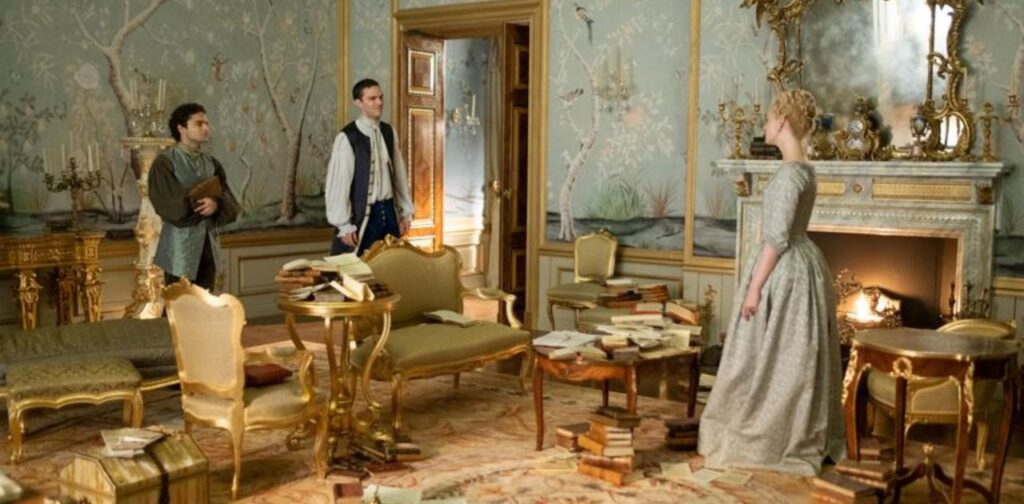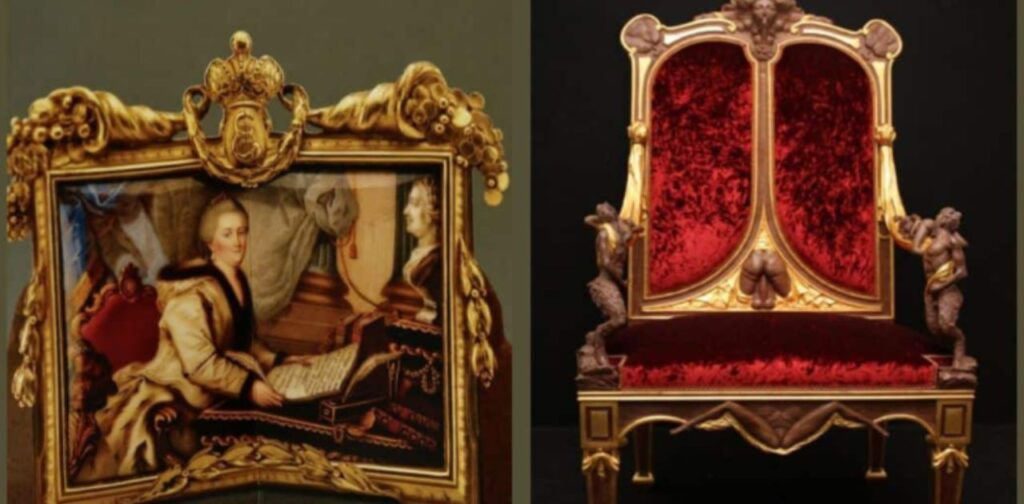In the grand tapestry of history, few threads shine as brightly as that of Catherine the Great, the German princess who became Empress of Russia and left an indelible mark on the world. Born Sophie Friederike Auguste von Anhalt-Zerbst, Catherine’s reign from 1762 to 1796 was a period of immense cultural and political transformation for the Russian Empire.
Among her many legacies, one of the most fascinating and controversial is her legendary furniture collection. This article delves into the captivating world of Catherine the Great furniture, exploring its historical significance, artistic value, and the swirling myths that have captivated imaginations for centuries.
Catherine the Great: The Woman Behind the Furniture
Before we dive into the intricacies of her furniture collection, it’s crucial to understand the woman who commissioned these pieces. Catherine’s rise to power was as dramatic as any Hollywood script. After marrying the future Peter III in 1745, she bided her time, learning Russian, embracing the Orthodox faith, and cultivating allies. When Peter ascended to the throne in 1762, Catherine saw her opportunity. Within months, she orchestrated a coup, overthrowing her husband and claiming the crown for herself.
Catherine’s reign was marked by a fervent passion for the arts and culture. She saw herself as an enlightened despot, corresponding with Voltaire and Diderot, and seeking to modernize Russia through cultural refinement. This love for art and innovation would profoundly influence her tastes in furniture and interior design.
“I am an enlightened monarch and I want my country to be represented at its best.” – Catherine the Great
Her ambition extended beyond mere aesthetics. Catherine understood the power of visual symbolism in reinforcing her authority. Each piece of furniture in her palaces was carefully chosen not just for its beauty, but for its ability to project an image of Russian power and sophistication to both domestic and foreign audiences.
The Influence of Catherine the Great on Furniture Design

Catherine’s impact on furniture design was nothing short of revolutionary. She blended Russian traditions with European styles, particularly French and Italian, creating a unique aesthetic that would define the era. Her furniture choices reflected not just personal taste, but also political savvy – each piece was a statement of Russia’s growing cultural sophistication.
Key aspects of Catherine the Great furniture include:
- Neoclassical influences: Clean lines and symmetrical designs inspired by ancient Greece and Rome
- Luxurious materials: Extensive use of gilded wood, precious stones, and exotic veneers
- Mechanical innovations: Furniture with hidden compartments and transformative capabilities
- Symbolic motifs: Russian imperial symbols integrated with classical imagery
- Baroque elements: Ornate carvings and elaborate decorations, especially in earlier pieces
Catherine’s mechanical table, a marvel of 18th-century craftsmanship, exemplifies her forward-thinking approach to furniture design. This ingenious piece could transform from a writing desk to a dining table, showcasing both practicality and luxury. It’s a testament to Catherine’s fascination with innovation and her desire to impress foreign dignitaries with Russian ingenuity.
The Empress also had a penchant for creating themed rooms, each with its own unique furniture set. For instance, her famous Amber Room, while not strictly furniture, demonstrated her love for opulent and innovative interior design. This room, covered in amber panels backed with gold leaf and mirrors, was considered an eighth wonder of the world before its mysterious disappearance during World War II.
Rumors and Legends: The Spicy Side of Catherine’s Furniture
No discussion of Catherine the Great furniture would be complete without addressing the salacious rumors that have swirled around it for centuries. The most infamous of these is the legend of her X-Rated Furniture collection – a supposed suite of rooms filled with erotic art and furniture of an explicit nature.
While these stories have captivated the public imagination, it’s important to approach them with a critical eye. Many historians argue that these tales are likely exaggerations or outright fabrications, born from a combination of Catherine’s reputation as a passionate woman and the human tendency to sensationalize the lives of powerful figures.
The Mystery of the X-Rated Furniture
The legend of Catherine’s erotic furniture collection typically includes descriptions of chairs, tables, and other pieces adorned with explicit carvings or paintings. Some stories even claim the existence of furniture shaped like human bodies in compromising positions.
However, it’s crucial to consider the historical context. While the 18th century certainly had its share of erotic art, the idea of an entire suite of rooms dedicated to such pieces stretches credibility. Moreover, no concrete evidence of such a collection has ever been found.
These rumors likely stemmed from Catherine’s well-known series of lovers, including her long-time partner Grigory Potemkin. The Empress’s open approach to her relationships, unusual for the time, may have fueled wild speculation about her private life and, by extension, her private quarters.
Catherine the Great’s Bedroom: Fact vs. Fiction
Catherine the Great’s bedroom has been a subject of much speculation. In the popular imagination, it’s often portrayed as a den of iniquity, filled with scandalous furniture and secret passageways. The reality, based on historical records, was likely far more mundane – albeit still luxurious.
Contemporary accounts describe Catherine’s bedroom as elegant and refined, with neoclassical furnishings and fine artworks. The bed, a centerpiece of royal symbolism, was likely an ornate affair, but not the stuff of legend that later stories would claim.
One particularly persistent myth involves Catherine’s death, with lurid tales involving a horse and a collapsing bed. In reality, Catherine died of a stroke in her bathroom, a far less sensational but no less significant end to a remarkable life.
The Infamous Suite of Rooms: Urban Legend or Hidden Truth?
The story of Catherine’s secret erotic chambers has persisted for centuries, gaining new life with each retelling. According to the legend, these rooms were hidden within her palace, accessible only to the Empress and her closest confidants.
While the idea of secret rooms is certainly tantalizing, architectural evidence and historical records provide little support for their existence. The persistence of this urban legend speaks more to our fascination with the private lives of historical figures than to any historical reality.
It’s worth noting that many palaces of the era did include private apartments for the monarch, often with separate entrances for discreet visitors. However, these were more likely used for private meetings and relaxation than for housing scandalous furniture collections.
The 1941 Wehrmacht Discovery: A World War II Twist
One of the most intriguing chapters in the story of Catherine the Great furniture came during World War II. In 1941, during the Nazi invasion of the Soviet Union, two Wehrmacht officers reportedly discovered a collection of erotic furniture in one of Catherine’s palaces.
This alleged discovery reignited interest in the legend of Catherine’s X-rated furniture. However, like many aspects of this story, the details are murky. Some historians suggest the “discovery” may have been a fabrication, either by the officers themselves or by later storytellers. The lack of photographic evidence or official documentation leaves this tale firmly in the realm of speculation.
The timing of this “discovery” is particularly suspect, coming at a time when Nazi propaganda was keen to portray Russian culture as decadent and degenerate. It’s possible that the story was invented or exaggerated to serve these political ends.
French Flair: The Role of French Furniture Makers
While the erotic legends may be questionable, there’s no doubt about the significant influence of French furniture makers on Catherine’s collection. The Empress was a known Francophile, and she invited numerous French artisans to work at the Russian court.
These craftsmen brought with them the latest styles and techniques from Paris, blending them with Russian aesthetics to create pieces of unparalleled beauty and craftsmanship. The result was a unique fusion of French elegance and Russian grandeur that would define the style of the Russian court for generations.
Notable French artisans who worked for Catherine include:
- Jean-Baptiste Greuze: A painter known for his sentimental genre scenes
- Jean-François Michel: A master cabinetmaker who created exquisite furniture for the Empress
- Louis-Joseph Le Lorrain: An architect and designer who helped shape the neoclassical style in Russia
Their work helped establish a new standard of luxury and refinement in Russian furniture design. Catherine’s patronage of these artists not only elevated the quality of Russian craftsmanship but also served as a diplomatic tool, strengthening cultural ties between Russia and France.
Read Also: Prince Narula Digital PayPal A Game-Changer in Entertainment and Finance
Catherine’s Furniture Legacy: Impact on Russian Culture
The influence of Catherine the Great furniture extended far beyond her reign, shaping Russian design aesthetics for generations to come. Her taste for neoclassical elegance, combined with traditional Russian motifs, created a distinctly Russian style that would be emulated by future monarchs and aristocrats.
This cultural impact was not limited to furniture. Catherine’s patronage of the arts extended to architecture, painting, and sculpture, transforming St. Petersburg into a city that rivaled the great capitals of Europe in its cultural richness.
Today, examples of Catherine the Great furniture can be found in museums around the world, testifying to their enduring artistic and historical value. These pieces offer a tangible link to a pivotal period in Russian history, when the empire was asserting itself as a major European power through both military might and cultural sophistication.
Some notable pieces include:
- The Bureau Cabinet in the Hermitage Museum, a masterpiece of Russian craftsmanship
- The Chesme Table, an intricate piece commemorating a naval victory over the Ottomans
- The Diamond Throne, a symbol of imperial power now housed in the Kremlin Armoury
Each of these pieces tells a story not just of artistic achievement, but of the political and cultural ambitions of an empire in ascendance.
Conclusion
The story of Catherine the Great furniture is a fascinating blend of historical fact, artistic innovation, and colorful legend. While we may never know the full truth behind some of the more salacious tales, there’s no denying the significant impact Catherine had on the world of design and craftsmanship.
From her mechanical marvels to her patronage of French artisans, Catherine’s furniture collection reflects the complex personality of a ruler who sought to modernize her empire while indulging her passion for luxury and innovation. As we continue to study and admire these pieces, we gain not just an appreciation for fine craftsmanship, but a deeper understanding of a crucial period in European history.
Catherine’s legacy in furniture and design is a testament to the power of art as a tool of statecraft. Through her patronage and personal taste, she helped shape not just the aesthetic sensibilities of Russia, but its very identity as a European power. The enduring fascination with Catherine the Great furniture speaks to the timeless allure of beauty, power, and just a hint of scandal.
FAQs
What was Catherine the Great furniture known for?
Catherine the Great furniture was renowned for its blend of Russian and European styles, innovative designs (like mechanical tables), and use of luxurious materials.
What is Catherine the Great famous for besides her furniture?
Catherine is famous for her role in modernizing Russia, her patronage of the arts, and her military expansions that greatly increased the Russian Empire’s territory.
Are there any living descendants of Catherine the Great?
Yes, many European royal families, including members of the British royal family and Danish royal family, can trace their lineage back to Catherine the Great.
Who was Catherine the Great’s longest lover?
Grigory Potemkin, a Russian military leader and statesman, is generally considered to have been Catherine’s most significant and long-lasting romantic partner.
Key Takeaways
- Catherine the Great’s furniture collection reflects her role as a cultural innovator and patron of the arts.
- The blend of Russian and French styles in her furniture had a lasting impact on Russian design.
- While legends of erotic furniture persist, they should be approached with historical skepticism.
- Catherine’s mechanical table exemplifies the innovative spirit of her reign.
- The influence of French craftsmen was crucial in shaping the style of Catherine’s court.
- Catherine the Great furniture continues to fascinate historians and art lovers, offering insights into 18th-century Russian culture and politics.
Latest Article

Youthful insight with exceptional writing skills, delivering engaging and thought-provoking content.



